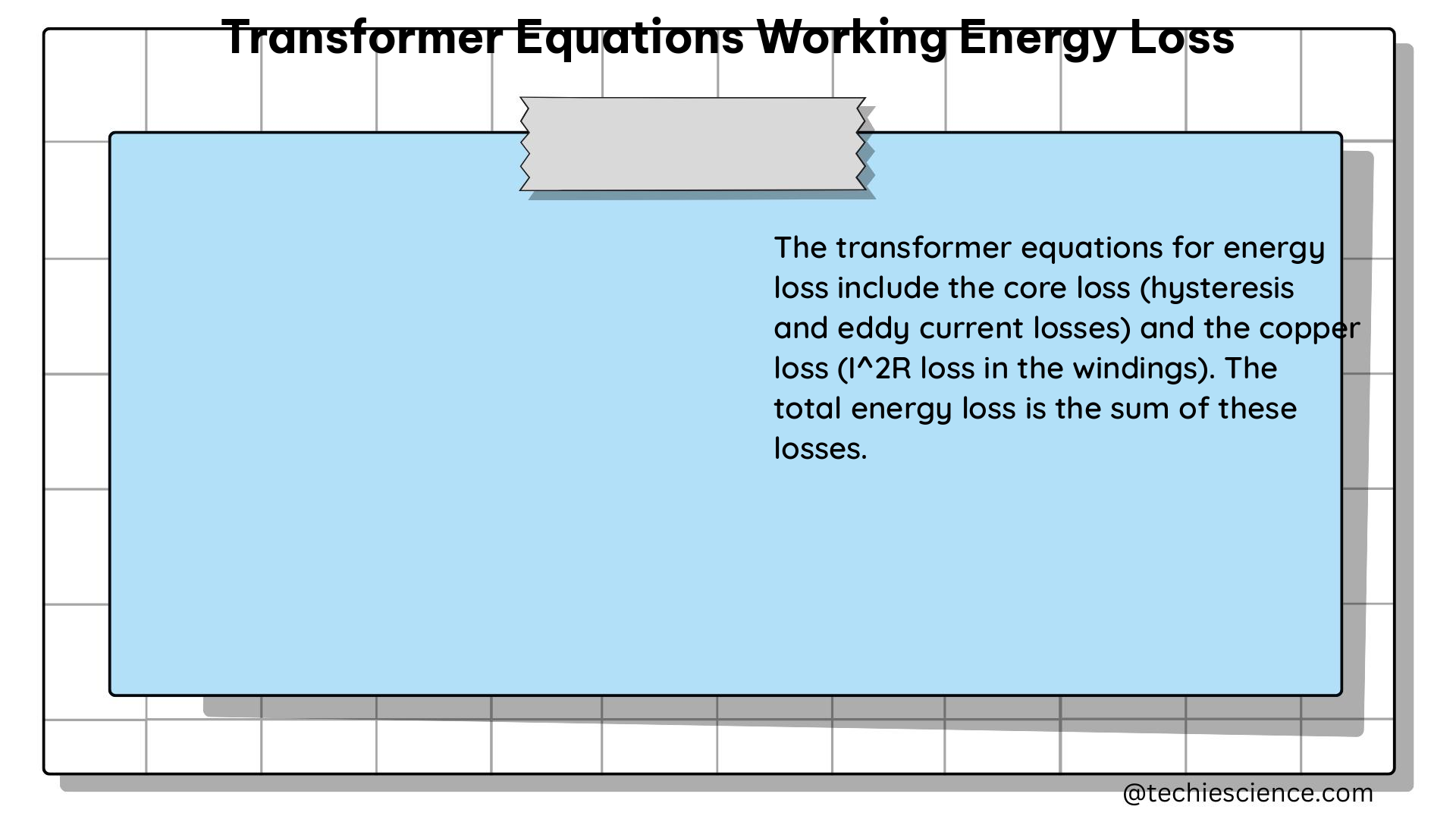Transformer equations play a crucial role in understanding and quantifying the energy losses associated with transformer operations. This comprehensive guide delves into the technical details, data points, and research insights that shed light on the complex dynamics of transformer energy losses, equipping physics students with a robust understanding of this essential topic.
Transformer Losses Due to Harmonics
Harmonics, which are distortions in the sinusoidal waveform of the electrical supply, can significantly contribute to energy losses in transformers. Let’s explore the quantifiable data points that illustrate the impact of harmonics on transformer performance:
Transformer Losses
- Total Losses in Transformer Due to Harmonics: 3.7 kW
- Cable Losses Due to Harmonics: 0.74 kW
- Total Savings After Installation of Filter: 4.4 kW
These figures demonstrate the substantial energy losses that can be attributed to harmonics in the electrical system, highlighting the importance of implementing effective mitigation strategies.
Power Factor Improvement
- Power Factor Before Installation of Advanced Universal Passive Harmonic Filter: Not specified
- Power Factor After Installation of Advanced Universal Passive Harmonic Filter: 0.99
The significant improvement in power factor, from an unspecified value to 0.99, illustrates the positive impact of the harmonic filter on the overall power quality and efficiency of the transformer system.
KVA Reduction
- KVA Before Installation of Filter: 88.6 KVA
- KVA After Installation of Filter: 68.5 KVA
- Total KVA Savings: 20 KVA
The reduction in KVA, from 88.6 to 68.5, showcases the substantial capacity savings achieved through the installation of the harmonic filter, further enhancing the overall efficiency and performance of the transformer.
Return on Investment (ROI)
- Filter Cost: ₹2,10,000
- Total Savings Per Year: ₹3,62,112
- ROI: 7 months
The impressive return on investment, with a payback period of just 7 months, underscores the financial benefits of implementing effective harmonic mitigation strategies in transformer systems.
Loss Reduction Strategies

Alongside the quantifiable data on the impact of harmonics, various loss reduction strategies have been explored in the research, offering valuable insights for physics students:
Line Loss Interval
- Line Loss Interval Estimation: A model can estimate the reasonable line loss interval based on transformer operation data.
This approach allows for a more accurate assessment of line losses, enabling better optimization and management of the transformer system.
Loss Modelling
- Accurate Loss Modelling: Static piecewise linear loss approximation based on line loading classification can achieve accurate loss modelling.
Precise loss modelling is crucial for understanding the energy dynamics within the transformer and developing effective strategies to minimize losses.
Line Loss Calculation
- Line Loss Calculation Method: A method based on big data and load curve can be used for line loss calculation.
The utilization of big data and load curve analysis provides a comprehensive approach to estimating and managing line losses, contributing to the overall efficiency of the transformer system.
Energy Conservation Standards
Regulatory bodies, such as the U.S. Department of Energy (DOE), have established guidelines and standards to promote energy efficiency in transformer systems. These standards offer valuable insights for physics students:
Energy Efficiency
- DOE Guidance: The U.S. Department of Energy (DOE) advises on analytical methods, data sources, and key assumptions for energy conservation standards in distribution transformers.
Understanding these energy conservation standards and the underlying analytical approaches can help physics students develop a deeper understanding of the regulatory landscape and its impact on transformer design and operation.
Research on Transformer Operation
The research landscape on transformer operation has yielded valuable insights that can enhance the understanding of physics students:
Fuzzy Comprehensive Evaluation
- Transformer Working State Evaluation: A multi-level evaluation method based on key performance indicators can be used to evaluate the working state of transformers.
This comprehensive evaluation approach provides a holistic assessment of transformer performance, enabling better monitoring and optimization of the system.
Transformer Losses and Temperature Rise
- Correlations in Transformer Operation: The heating temperature rise has correlations to the loading current, power losses, efficiency, and surface area.
Exploring these correlations between transformer parameters can help physics students develop a more nuanced understanding of the complex relationships that govern transformer energy losses and efficiency.
By delving into the technical details, data points, and research insights presented in this comprehensive guide, physics students can gain a deeper understanding of the intricate dynamics of transformer equations and their impact on energy losses. This knowledge will equip them with the necessary tools to tackle real-world challenges in the field of power systems and transformer design.
References
- https://www.linkedin.com/pulse/incredible-power-losses-caused-harmonics-measurable-waveforms
- https://www.sciencedirect.com/science/article/abs/pii/S0306261921014021
- https://www1.eere.energy.gov/buildings/appliance_standards/pdfs/dt_nopr_tsd_complete.pdf
- https://link.springer.com/chapter/10.1007/978-981-97-3940-0_6
- https://www.researchgate.net/publication/326317282_Investigation_of_transformer_losses_and_temperature_rise
Hi, I am Amrit Shaw. I have done Master in Electronics.
I always like to explore new inventions in the field of Electronics.
I personally believe that learning is more enthusiastic when learnt with creativity.
Apart from this, I like to strum Guitar and travel.